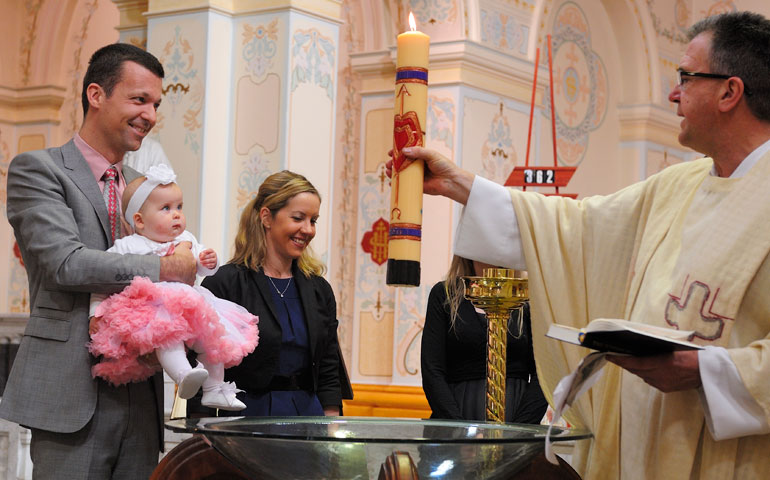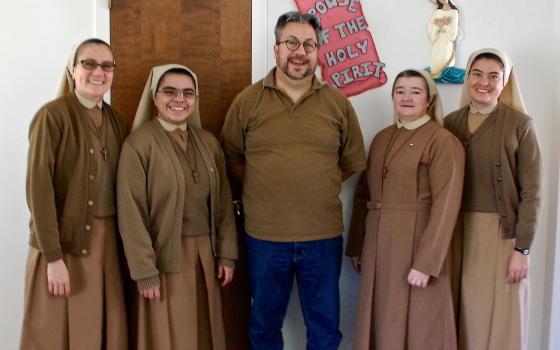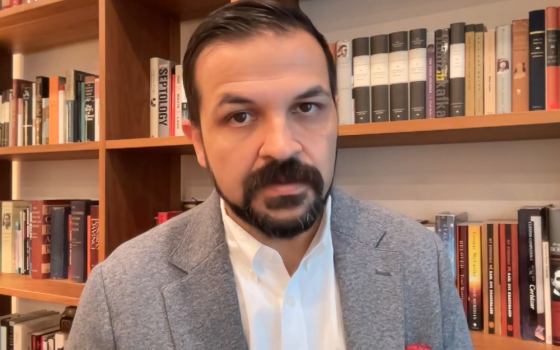
Fr. John Petrulis, right, leads the baptism of a young Catholic at Sacred Heart Parish in Melbourne, Australia. (Maria George)
Sacred Heart Mission in the St. Kilda section of Melbourne, an inner-city refuge for mainly homeless and troubled men, the highest percentage of whom are dealing with some form of mental illness, was a swarm of gentle chaos on a Sunday morning in mid-November.
Volunteers were serving a meal in a parish hall that seems an extension of the nearby church. Or perhaps it is the other way around, for it appears to be a seamless connection between sanctuary and ministry, and it's been that way since the day in 1982 when Sacred Heart Parish's then-pastor, Fr. Ernie Smith, opened his door to share a meal with a man who was homeless.
The story is as Catholic as Catholic gets in the modern era: It wasn't long before the parish staff was serving meals from the presbytery's kitchen, according to a history of the place. Within a year, the number had grown to 70 a day and today the parish's dining hall serves breakfast and lunch every day of the year to hundreds of people in need.
Sacred Heart Mission, explains Fr. John Petrulis, the current pastor, is now a separate nonprofit entity from the parish, but that is largely a paper formality. The reality is that the parish is intimately tied to the work of the mission.
As the meal service has expanded, so have other ministries associated with the mission. The standalone nonprofit had an annual budget of more than $14 million in 2012, funded by a combination of federal, state and local government money, donations from individuals and groups, as well as support from the Melbourne archdiocese.
Petrulis said the staff numbers nearly 200 full- and part-time and the work is augmented by a partnership with a local hospital's psychiatric team, which works with mission staff on preventive measures, and it has cooperated with professionals studying links between trauma and homelessness.
Petrulis sees the connection between parish and mission as essential. He is a member of the board; parishioners work as volunteers at the mission and at two hostels that house about 80 people "who don't have much backup with family connections."
The former primary school is being turned into a facility for elder care and pastoral associates also work as chaplains in the mission services. "It is a major focus in our parish life." A nearby parish also encourages children to come visit the elderly in the hostels. "We like to create a spirit of family for those who don't have family," Petrulis said.
While all of this has been developing over decades with wide support from the community and the church, Petrulis admits to a "Francis effect." He feels more encouraged, he said, "in terms of being where the people are and getting to the essentials, that call to get back to the Gospel imperatives."
* * *
For Damian Coleridge, a longtime activist in the church in the Melbourne archdiocese and guide for a portion of this trip, Sacred Heart Mission stands as an example of two important trends in the contemporary church. It is a sign of what is going on creatively already at the parish level that shows a direction to the future and it is an example of the imagination required to move beyond the failing old forms that have defined Catholicism here for the past century and a half.
An art historian (he taught the subject for some years at the Victorian College of the Arts), he also worked at the parish level for the now-legendary Fr. Bob Maguire, an iconoclastic pastor who oversaw an inner-city parish with vibrant ministry and sacramental life and has been the subject of at least two books and a film.
Coleridge is connected to Australia's Catholic culture in other ways. His brother, Mark, is archbishop of Brisbane. His wife, Margaret Coffey, is an award-winning radio producer and presenter for the Australia Broadcasting Corporation. One of her recent productions for the series "Encounter" is a richly textured treatment of the meaning of Eucharist, drawing on the experience of ordinary parishioners and exploring the meaning of the term and the event from historical perspectives as well as those from other religious traditions.
From his time with Maguire, Coleridge remembers his introduction ("quite by accident") to a liturgy that expanded from the sanctuary to people in the streets, kids and people on the margins of things, so that liturgy on Sunday became a moment "when all of that came together."
"My way of saying it years later about this experience with this extraordinary group of people -- rich and poor, educated and those without education, with people who had taught at university and people who had never gone near a university, male and female, young, old, all in it together -- years later I realized what had happened, I'd discovered the body of Christ," he said.
His life, he said, had taken a turn at that point and there was no going back. "This extraordinarily motley mob, unforgettable people, they changed my life forever."
Coleridge knows the tale of diminishment. As in the United States, the Catholic church here remains the single largest Christian denomination, with a total of 5.4 million Catholics, or 25.3 percent of the total Australian population of 21.5 million.
By comparison, the U.S. Catholic population is either 66.8 million (based on figures from the Official Catholic Directory) or 78.2 million (based on those who self-identify in polling), out of a total population of nearly 314 million, according to data of the Center for Applied Research in the Apostolate at Georgetown University.
In both cases, the numbers are bolstered by immigration at the same time that significant numbers are leaving the church, and the numbers of nuns, priests and Massgoers have been in steady decline over decades.
In each case, the number of "nones" or those of no religious affiliation, is on the rise. According to a 2012 report by the Pew Research Center, "One fifth of the U.S. public -- and a third of adults under 30 -- are religiously unaffiliated," the highest percentage Pew had ever polled.
A December 2013 article in the Herald Sun newspaper here, citing figures from the Australian Bureau of Statistics, reported that those choosing no religious affiliation "have been steadily rising," jumping over a century period "from one in 250 in 1911 to more than one in five in 2011."
Most of that loss was among Christian denominations. And even many who specify a religious affiliation "do not actively participate in religious activities," according to the report. The lack of affiliation reached nearly 50 percent of those under 30.
Given that grim picture, Coleridge remains convinced that the body of Christ, especially the Catholic version, is not disappearing as much as it is changing. Sometimes the way to the future is not always evident, he says, and mentions the current pope. "The way to the future was Buenos Aires? Who would have thought that?"
He notes other work occurring at the parish level, the programs that have been presented by young theologians at Australian Catholic University as well as those from the United States and from Southeast Asia.
"Most of the good stuff, the things going on that point to the future, are happening under the radar."
Pope Francis, he believes, captures the imagination, "because he's retelling the story of the Gospel in a new way. It's fresh. We're surprised in a good way by the story he's telling."
* * *
What is clear, however, is that Francis and the enthusiasm he's generated still don't answer some fundamental questions about what parish life will be like in a future fairly bereft of the infrastructure of nuns and priests that kept things together for so long.
Fr. Brian Lucas, secretary of the Australian Catholic Bishops Conference, said, "Without a doubt, it's a lack of imagining for the future."
"I think we have some serious issues about the diminishment of the clergy and the amalgamation of parishes," he said. "You send a message to the people about diminishment that becomes what you might call a self-fulfilling prophecy. You're basically saying we haven't got the wherewithal to provide for your pastoral needs because we don't have enough clergy. I wonder if that sends a subliminal message: We don't think that matters -- why should you think that matters?"
He raises particularly the problem of remote, small communities of Catholics in Australia. He describes the case of a parish in the Canberra archdiocese where he lives, a place about four and a half hours' drive from the city of Canberra where there are 200-300 Catholics. Such circumstances exist throughout the vastness of Australia. "And you think to yourself, can you sustain having a priest, a full-time celibate priest, with such small communities? Or do we have to imagine a different model?"
But isn't that raising questions (he mentioned discussion of married priests) we've been told we can't even ask?
"No one can say you can't ask the question," Lucas responded. "You've got to ask the question. Is there another model of pastoral ministry that can break away from that particular way things have been done?"
Some members of the staff of Jesuit Communications Australia believe the process in much of the Catholic structure is already well beyond the imagining stage. The organization's publications include Eureka Street, once a print publication and now an online offering of lively analysis and opinion steeped in the church's social justice tradition. Another of its publications is Australian Catholics, published in print five times a year.
Michael McVeigh, editor of Australian Catholics magazine, during a discussion with staff on a balcony outside the offices of the publications in Melbourne, said one element of the Australian Catholic story is that "laypeople are taking over all of these organizations, taking leadership positions in the schools, in the social ministries, in the health care institutions." All of that, he said, "is actually causing a kind of quiet revolution in the church."
Damien Nolan, director of Jesuit Communications, judged that the "quiet revolution" had been accomplished. New structures and boards incorporating laypeople have been formed for most church institutions. "The quiet revolution happened because it had to happen."
For Nolan, the issue that no one talks about, but he sees as one of the major reasons for the demographic disaster, is "the fact that the church has basically treated women so badly in terms of their issues." Women, he said, "are the nest protectors," important in passing on the faith, "and what you've actually done, you've frightened off all the nest protectors out there. … What the church has got now has come about because the church has failed to engage with its strongest allies."
The data might bear out that last point about loyal allies. The most recent update (2012) to a study, "Catholic Parish Ministry in Australia: The Crisis Deepens," reports that more than 30 percent of parishes are without a full-time resident priest. Lay associates and lay pastoral workers, overwhelmingly women, made up almost 20 percent of all parish ministers.
Kate Fogarty, principal of St. Joseph's College, the equivalent of a high school in the United States, is emblematic of other points made in conversations here: Women are increasingly in positions of authority in some areas of the institutional structure and Catholic schools are in the vanguard of Catholic identity here. "I think that many people recognize that for a large portion of the population, the Catholic schools are the face of the church in Australia, rather than the parishes," said Fogarty.
It is a curious phenomenon because if Mass attendance, for instance, is at an all-time low, the schools are packed. Fogarty said her school in Echuca in the Melbourne archdiocese "turns away a quarter as many kids as we take in each year." In all, it is estimated that 25 percent of Australian children attend Catholic schools -- those systems run by dioceses and one of three general tiers in the education system here. A larger portion attend public schools, which are entirely government-funded, and a much smaller percentage attend private schools, those run by individuals or other religious denominations or, for instance, more exclusive Catholic schools run by religious orders such as the Jesuits.
Fogarty said many of the families she's interviewing who want their children in Catholic schools are not practicing Catholics. She estimates that only 50 to 60 percent of the families involved in the school are Catholic and that many of them would not even be baptized themselves. She said that in other areas of the countries, a school's population might be near 100 percent Catholic, "but the percentage of those who are practicing Catholics would be anyone's guess."
Catholic schools here benefit in two ways from generous government funding. The government subsidies make schools more affordable and are in part the reason that the Catholic teachers union is awarded the same level of compensation and benefits as the union for public school teachers.
* * *
If the revolution is either underway or completed, it has been, indeed, a quiet one. Churches, though fewer, still look the same, and parishes are generally structured along traditional lines. Not surprisingly, survival involves a mix of old and new.
In the case of Fr. Michael Sierakowski and Holy Trinity Parish (the name here has hidden significance, since it is the new name for a merger of three parishes), it was a matter of two of the parishes simply running out of priests. The consequence, he said, is that "an experiment fell into our lap."
He sought permission to merge the three Melbourne archdiocese parishes, using three retired priests to make sure Masses are covered in the three churches. "But I also said to the archbishop, the experiment only works with pastoral associates." Eventually, there were five of them, all women. As well, a woman is secretary and two of the principals of the parish elementary schools are women, the other is a layman.
The pastoral associates, he said, "do the majority of the work -- visitations, keeping the community energized. The retired priests don't want any parish responsibilities and [Sierakowski said with great emphasis] they don't want to attend meetings. They'll say to me, 'Are you free tonight?' and I'll say, 'No, I have another meeting,' and they just burst out laughing and go for another beer."
Sierakowski said that he told the bishop, "If you want this, you have to support us. We need wages for the pastoral associates, we need proper living facilities for the priests, and we need to work this together. And he said, 'Yes, of course.' "
The three former parishes have been acting corporately for three years and as the pastoral associates and others joined in the conversation, it became clear that those retired priests were spared quite a few meetings, gatherings that dealt with details about how the schools would work together, how finances would work, how the communities would both keep their own identities yet share an identity.
"The question is surely, 'What's in the future?' " Sierakowski said. "The parishioners are ready for the next stage. The laity are ready for the next stage. The Australian Catholic bishops won't allow that vision to be addressed. ... The imagination stops there."
There is agreement around the group of pastoral associates and others gathered in a parish sitting room that there is a certain inevitability regarding the future, that the demands of sacramental ministry coupled with the shortage of priests will force some change. Exactly what and how remains the unknown. "How do you respond with a new model?" asked Sierakowski. "I don't know," he said. "I don't know."
[Tom Roberts is NCR editor at large. His email address is troberts@ncronline.org.]



